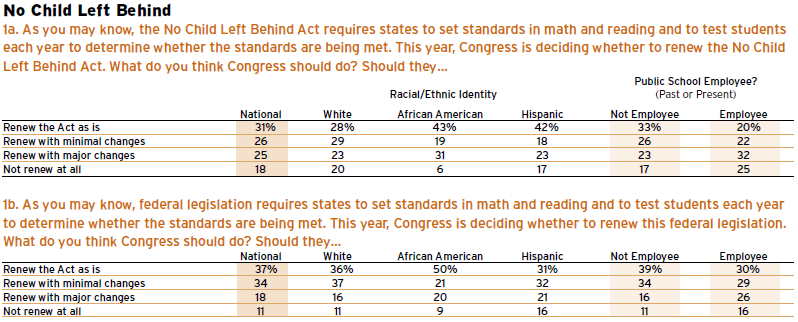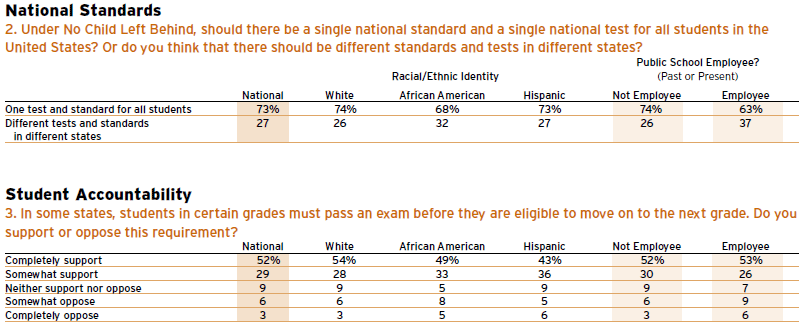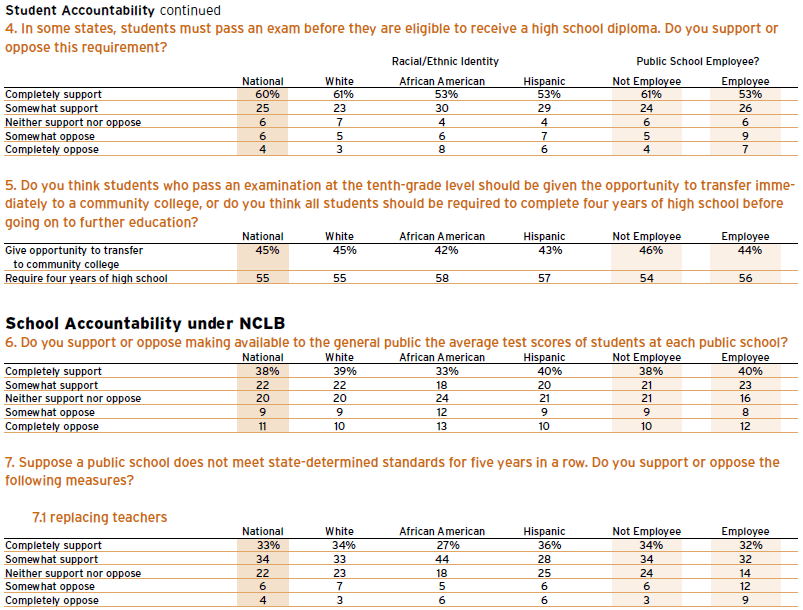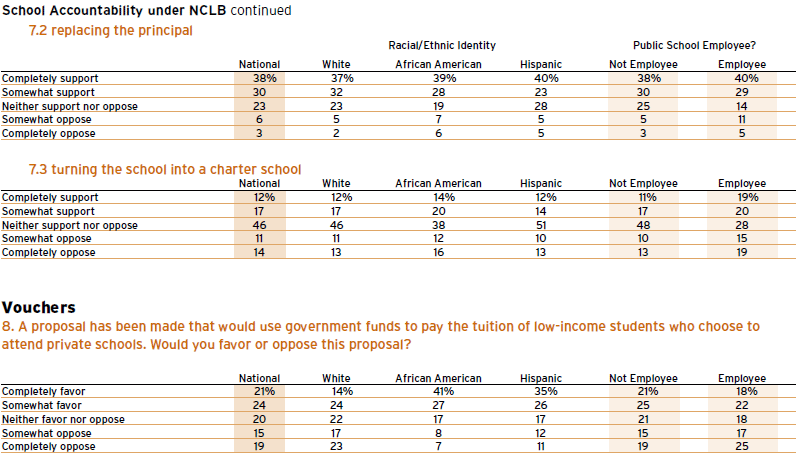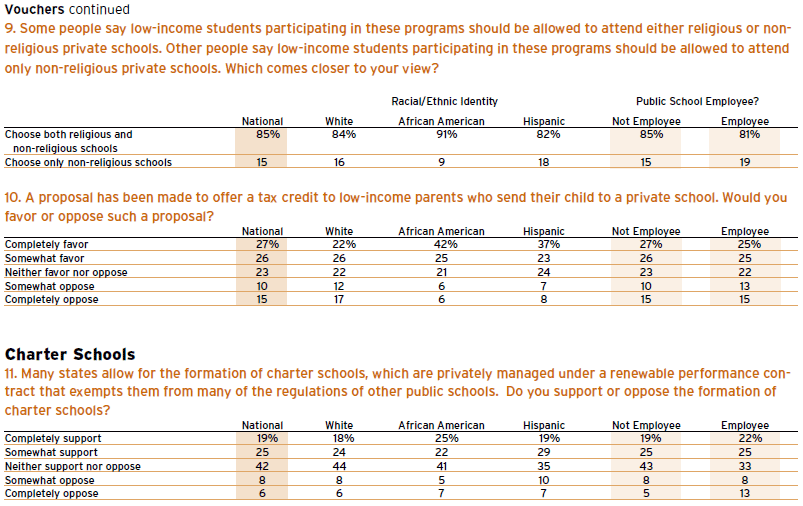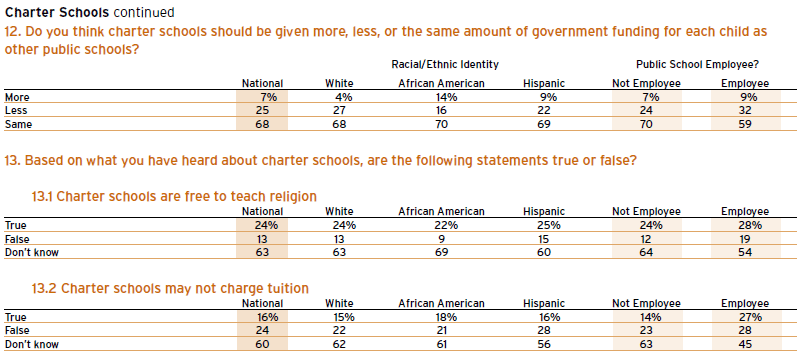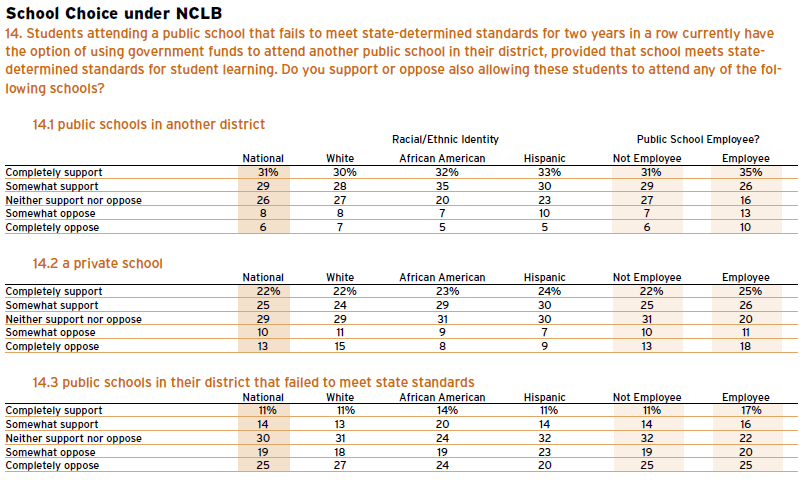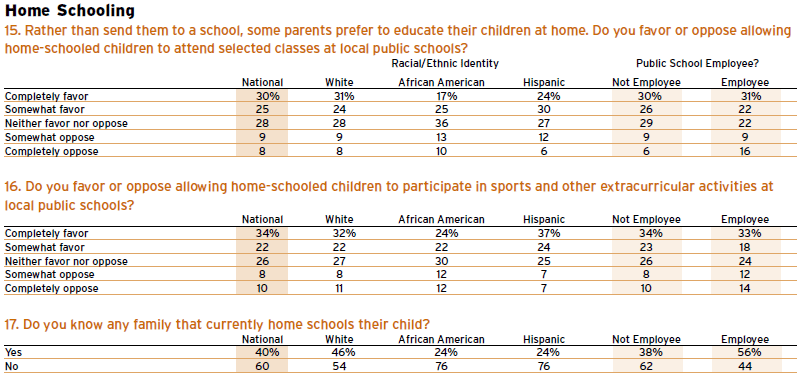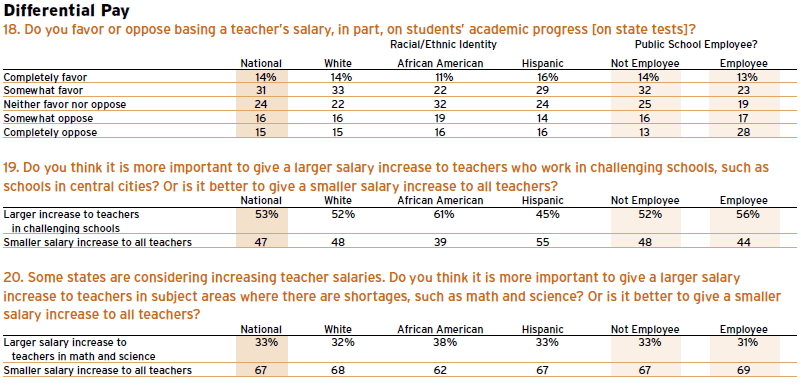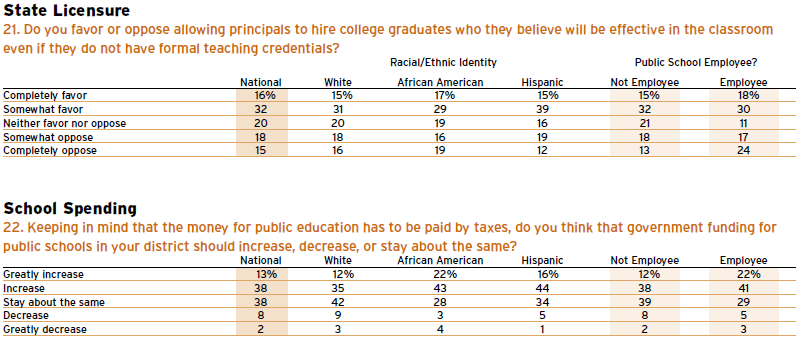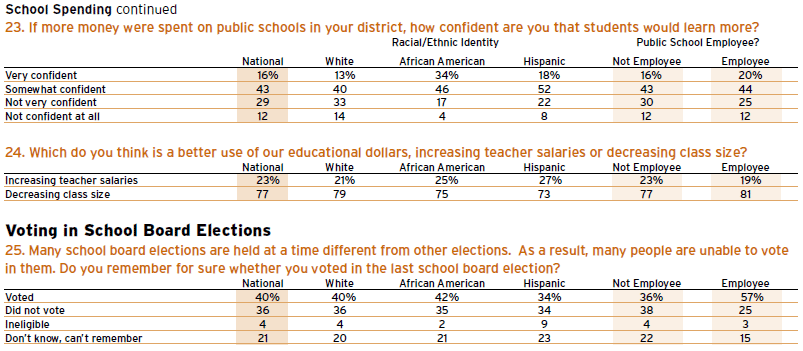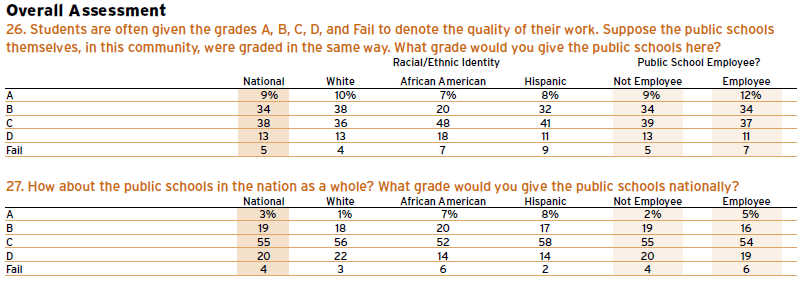Americans both care about their schools and want them to improve. Though adults give the nation’s public schools only mediocre grades—a plurality confer a “C”—they are willing to invest more money in public education and they are reasonably confident that doing so will improve student learning. They are also open to a host of school reforms ranging from high-stakes student accountability to merit pay for teachers to school vouchers and tax credits that would give low-income families greater access to private schools. By sizable margins, they back reauthorization of No Child Left Behind (NCLB), the federal law that mandates school accountability.
The public, however, also appears selective in its desire for change. Americans balk at some market-based reforms, such as paying more for teachers who work in fields like math and science, where quality teachers are in scarce supply. And substantial percentages remain undecided about charter schools and other reform initiatives, suggesting that the current national debate over school policy has the potential to sway public opinion in one direction or another.
All this—and more—is indicated by a new national survey of U.S. adults conducted under the auspices of Education Next and the Program on Education Policy and Governance (PEPG) at Harvard University. (For survey methodology, see sidebar) Here we report the opinions of both the public at large and three ethnic subgroups (whites, African Americans, and Hispanics). We also distinguish the views of those who have worked for the public schools from those who have not. Except for opinions on school choice issues, differences across ethnic groups are generally smaller than those between public school employees and those who have never been employed by the schools. Responses to survey questions are provided at the bottom of the ensuing pages.
Accountability
Perhaps the most popular school reforms are those that hold students and schools to account for their performance. Accountability policies take many forms, but the public generally supports the concept in all its guises, including the federal No Child Left Behind Act.
No Child Left Behind
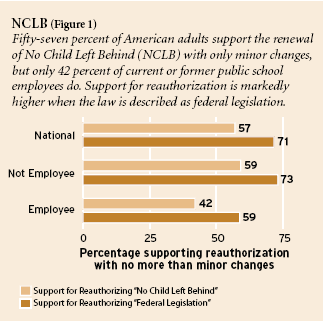 On the most high-profile issue of the day—the debate over extending the life of NCLB—a majority of those polled indicate that they support the law’s reauthorization with no more than minor changes (see Figure 1). NCLB requires states to establish performance standards in math and reading; to test students against those standards annually in grades 3 to 8 and again when students are in high school; and to intervene in schools that fail to make adequate annual progress toward the goal of near-universal student proficiency by 2014. The 2002 law is scheduled for reauthorization this year.
On the most high-profile issue of the day—the debate over extending the life of NCLB—a majority of those polled indicate that they support the law’s reauthorization with no more than minor changes (see Figure 1). NCLB requires states to establish performance standards in math and reading; to test students against those standards annually in grades 3 to 8 and again when students are in high school; and to intervene in schools that fail to make adequate annual progress toward the goal of near-universal student proficiency by 2014. The 2002 law is scheduled for reauthorization this year.
Despite NCLB’s bipartisan origins, controversy has beset the statute ever since its passage. The law places unprecedented demands on the states, several of which have passed resolutions critical of it. Reporting on recent grass-roots efforts to overturn the law, Time magazine noted that “more than 30,000 educators and concerned citizens have signed an online petition calling for the repeal of the 1,100 page statute.”
It is perhaps surprising, then, that the American public holds NCLB in reasonably high regard. When asked for their view on the matter, 57 percent of respondents prefer that Congress renew the act either as is or with minimal changes. Still, the intense debate over NCLB appears to be eroding public support for the law as a symbol. When NCLB is described as “federal legislation” rather than mentioned by name, as was the case for a randomly selected half of our survey respondents, support for extending its accountability provisions rises to 71 percent (Q. 1a, 1b).
Similar levels of support are observed across ethnic lines, with never less than one-half of African Americans, Hispanics, or whites recommending that Congress renew the act as is or with minor changes, regardless of how the question is asked. Current and former public school employees, however, consistently register lower levels of support for NCLB.
National Standards
Just because the public favors reauthorization of NCLB does not mean that it opposes efforts to amend the act by establishing a single national standard. Currently, NCLB asks each state to set its own standards, design and administer its own tests, and establish its own definition of student proficiency. A number of prominent Washington think tanks, including the Thomas B. Fordham Foundation and the Center for American Progress, have argued that proficiency standards vary so widely that they should be replaced by a single national definition. But other groups, on both the right and the left of the political spectrum, oppose any single standard as unnecessary federal intrusion into local matters. Given the controversy surrounding all proposals to establish a uniform national standard, it is noteworthy that nearly three-quarters of the American public support the concept (Q. 2).
Student Accountability
Separate and apart from NCLB, which focuses on the performance of schools and districts, the public strongly supports reforms designed to hold individual students accountable for their performance on state tests. Currently, only a few states (e.g., Florida) and cities (e.g., Chicago and New York) require students to pass a test in order to move from one grade to the next, thereby modifying the practice of “social promotion,” which keeps youngsters with their peers by passing them to the next grade regardless of academic performance. Twenty-three states currently require students to pass an examination in order to graduate from high school, but the rest, a group that includes Illinois, Michigan, Pennsylvania, and Wisconsin, do not.
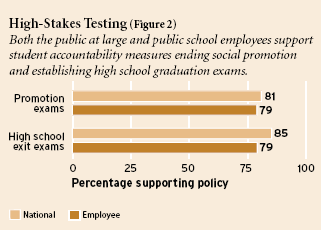
Despite the fact that holding students accountable for their performance is far from a universal practice in American education, student accountability commands widespread public support (see Figure 2). No less than 81 percent of all respondents support requiring students in certain grades to pass an exam before they proceed to the next grade, and 85 percent support requiring students to pass an exam before graduating from high school. Only 10 percent of respondents oppose either policy. African Americans, Hispanics, and current and former school employees are all modestly less likely to support graduation exams than other respondents, but in no case does more than 16 percent of a subgroup oppose the policy (Q. 3, 4).
Although Americans appear quite willing to use test results to determine the pace of students’ progress through school, they are less enthusiastic about using them to open up alternative routes into higher education. Only 45 percent of respondents support allowing students who pass an exam at the 10th-grade level to transfer immediately to a community college, as recently proposed by the New Commission on the Skills of the American Workforce. Rather, 55 percent of all respondents, and roughly the same share of each subgroup, support requiring students to complete four years of high school (Q. 5).
School Accountability under NCLB
High-stakes student accountability is more popular than the simple practice of publishing the average test performance of each school’s students. Only 60 percent of those surveyed support the latter policy, which is less stringent than the NCLB requirement that states publish the percentage of students in each school, and of various subgroups within it, that are proficient in math and reading. Just 20 percent of the public oppose publishing average test scores at the school level, with another 20 percent expressing neither support nor opposition (Q. 6).
NCLB also requires that schools be reconstituted if they fail to meet state-mandated performance benchmarks for five years in a row. Currently, states and districts are granted a great deal of flexibility in deciding how to reconstitute schools. Options range from minimal reorganization to replacing teachers and administrators to conversion into charter schools. When asked about these options, Americans express greater support for replacing teachers and principals than for converting failed district schools into charter schools. Roughly two-thirds of the adult population support replacing teachers and/or principals at persistently failing schools, and only one in ten opposes such options. Just 29 percent support converting the schools into charter schools. Still, that doesn’t signal widespread opposition to charter schools, a topic we return to below. Only 25 percent of the population actually opposed charter-school conversion, while fully 46 percent take no position one way or the other (Q. 7).
School Choice
Many accountability initiatives have long enjoyed the support of policymakers and the general public. More controversial in state and national policy discussions have been proposals to enable parents, especially low-income parents, to exercise greater choice over their children’s education through school vouchers, tax credits, charter schools, or home schooling. Despite that controversy, a plurality of the general public supports choice initiatives. African Americans and Hispanics express more support for school choice than do white Americans. Opponents of most forms of choice, meanwhile, constitute a fairly small segment of the American public, though many adults have yet to be persuaded one way or the other.
Vouchers
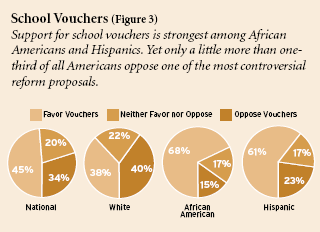
Few education reforms inspire as much debate as do proposals to provide low-income families with vouchers that would allow them to send their children to private schools. Apart from programs serving disabled students, only Wisconsin, Ohio, and Washington, D.C., have publicly funded voucher programs in operation. Elsewhere, state legislatures, referenda, and/or state courts have defeated proposed voucher initiatives.
Despite the legislative and legal disputes, a plurality of the public supports the voucher idea (see Figure 3). Forty-five percent of those surveyed favor offering vouchers to low-income families, 34 percent oppose the idea, and 20 percent neither favor nor oppose it. Both African Americans and Hispanics are markedly more likely to support vouchers than are whites. Indeed, 68 percent of African Americans and 61 percent of Hispanics favor vouchers, compared to 38 percent of whites. Only 15 percent of African Americans and 23 percent of Hispanics oppose vouchers, compared to 40 percent of whites (Q. 8).
When asked about the design of a school voucher program, 85 percent of Americans support allowing parents using vouchers to choose both religious and nonreligious private schools, a practice the U.S. Supreme Court upheld in 2002. Though African Americans appear slightly more likely to support the option of sending a child to a religious school, subgroup differences on this matter are small (Q. 9).
Tax Credits
Tax credit programs that help defray the cost of a private education are a less publicized, but more widely available, form of school choice than vouchers. Such programs exist in one form or another in several states, including Pennsylvania, Arizona, Minnesota, Illinois, and Florida. The greater incidence of tax credit programs could be due to the broader public support for this approach than for vouchers. Nationwide, 53 percent of adults favor tax credits, while only 25 percent oppose them, with another 23 percent neither favoring nor opposing the idea. As with vouchers, African Americans and Hispanics express the highest levels of support for tax credits (Q. 10).
Charter Schools
Compared to school vouchers and tuition tax credits, state legislatures have generally found charter schools to be more politically palatable. Charter schools are public schools of choice that are privately managed under a renewable performance contract that exempts them from many of the regulations that apply to other public schools. The first of these schools opened its doors in Minnesota in 1992, and their numbers have grown steadily since. In the 2006–07 school year, roughly 4,000 charter schools served 1.15 million students across 40 states and Washington, D.C.
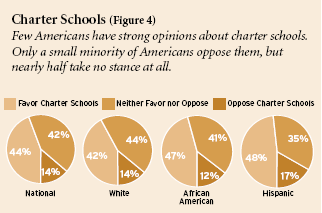
For the most part, Americans either express support for charter schools or opt not to take a position one way or the other (see Figure 4). Forty-four percent of respondents support their formation, and another 42 percent neither support nor oppose them. Only 14 percent of Americans oppose charter schools. Differences across subgroups are reasonably small, with slightly higher proportions of African Americans supporting charter schools and school employees opposing them (Q. 11).
Three-quarters of Americans also believe that charter schools should be given at least the same amount of funding per child as district-operated public schools, in contrast to the widespread state practice of awarding charter schools less funding. Even 68 percent of present or past school employees endorse funding charter schools at levels equivalent to (or better than) those of traditional public schools (Q. 12).
Though Americans appear cautiously supportive of charter schools, most are confused about them. For example, when asked whether charter schools are free to teach religion (they are not), or whether they can charge tuition (they cannot), almost two-thirds of the public confesses to not knowing the answer and another quarter offers the wrong answer. Indeed, only 13 percent of adults nationwide correctly note that charter schools cannot teach religion and 16 percent correctly observe that charter schools may not charge tuition (Q. 13).
Importantly, support for charter schools appears especially high among those adults who reveal higher levels of knowledge about them. Fully 66 percent of those adults who correctly answer both of the knowledge-based questions support charter schools, as compared to 38 percent of those who answer both incorrectly. Similarly, 81 and 68 percent of the two respective groups claim that funding for students in charter and other public schools should be equalized. Opposition to charter schools, to the extent that it exists, appears to be highest among those who know less about them.
School Choice under NCLB
Under NCLB, if a school has failed to meet the law’s accountability provisions two years in a row, parents have the option of sending their child to a higher-performing public school within the same district. But only about 1 percent of those eligible to move to a different school under NCLB have taken advantage of this option. As a result, choice advocates have proposed revisions in the legislation that would expand the range of options available to parents.
A clear plurality of the public at large supports revisions in NCLB to increase the number of choice options available to parents whose children attend low-performing schools. Sixty percent support allowing them to select a school in another district, a step that would vastly expand the range of options, yet has not received serious consideration in Congress. Only 14 percent oppose it. Meanwhile, 47 percent support giving parents the option of sending their child to a private school, and only 23 percent oppose it (Q. 14).
Americans reveal low levels of support for the option of sending children to a failing school within the same district. Only 25 percent express support, probably because the public sees scant benefit from moving a child from one failing school to another.
The number of American families opting to teach their children at home has increased dramatically in recent years. According to the National Center for Education Statistics, about 1.1 million students were being home schooled in the United States in 2003, the most recent year for which official data are available, up from roughly 850,000 students in 1999.
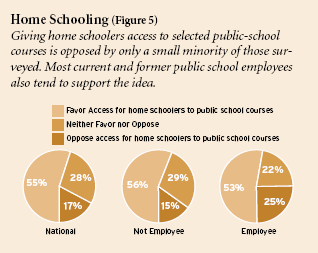
Forty percent of the public say they know a family that currently home schools its children. And most Americans support allowing home-schooled children to take advantage of public school resources (see Figure 5), including attendance in selected classes and participation in sports and other extracurricular activities. Americans who know a home-schooling family are especially likely to support a more expansive array of schooling options for them. Fully 68 percent of adults who themselves know a home-schooled child believe that such children should have the option of taking selected classes at local public schools, and another 61 percent support allowing them to participate in sports and extracurricular programs, as compared with 48 percent and 51 percent, respectively, of adults who do not know a home-schooled child (Q.15, 16, 17).
Teacher Pay and Licensure
Just as lively (and divisive) as the controversy over school choice and home schooling has been the debate over teacher pay and licensure. On these issues, pluralities of the public support some, but not all, reform proposals.
Differential Pay
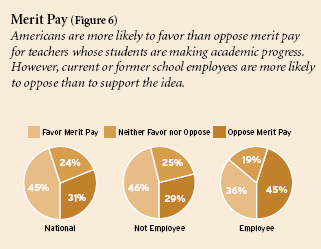
Although most scholars agree that teachers represent the single most important school contributor to a student’s academic progress, consensus breaks down as soon as the question turns to how best to design compensation systems to enhance teacher quality. On one side, the National Education Association defends the current practice of paying all teachers the same amount, except for differences based on past experience and graduate coursework. On the other side, groups such as the Teaching Commission, and the Progressive Policy Institute have proposed that we pay teachers according to how much students are learning in their classrooms (often as measured by test results), the difficulty of the teachers’ classroom environment or how hard it is to recruit quality teachers knowledgeable in a particular subject.
Though willing to entertain some reforms, the public is in no rush to abandon the traditional compensation system. Forty-five percent agree that a teacher’s salary should depend in part upon students’ academic progress while 31 percent disagree, and the remaining 24 percent choose not to express an opinion (see Figure 6). (Opinions about merit pay do not differ notably if Americans are asked about basing a teacher’s pay on “students’ academic progress” or on “students’ academic progress on state tests.”) A bare majority of Americans support increasing the salaries of those teaching in challenging school environments instead of using the same funds to offer all teachers a smaller pay increase. By a two-to-one margin, however, respondents would prefer to see new funds for teacher pay distributed equally across all teachers rather than targeted toward those in high-demand subject areas, such as math and science (Q.18, 19, 20).
State Licensure
To be fully certified, public school teachers in nearly every state must complete a requisite number of courses in education and the subject matter appropriate to their chosen area of instruction. In recent years, however, some states have modified this practice by allowing principals to hire college-educated individuals who have not completed the coursework ordinarily required for certification. The innovation remains controversial, as many education schools and teacher organizations believe that a teacher is only qualified after completing appropriate pedagogical training.
A plurality of the public, however, supports a more permissive teacher-recruitment policy. Forty-eight percent of those surveyed say that principals should be allowed to hire college graduates who lack formal teaching credentials, while only 33 percent oppose the idea, and 20 percent express no opinion. A larger share, 41 percent, of current and former school employees oppose the idea (Q. 21).
School Spending
The average amount of money spent per pupil by U.S. public schools has more than doubled in real terms since 1970, and the number of pupils per employed teacher has declined from 22 to 15. Teacher salaries have only barely kept pace with average wages nationwide, and the gap between teacher salaries and those of other college-educated workers has actually widened. Given these facts, some policy analysts claim that current spending levels are more than adequate and that further cuts in class size are unnecessary, while others say much more needs to be done, especially on the teacher salary front.
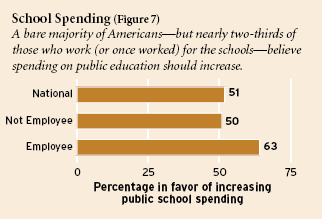
The public is closely divided on this issue (see Figure 7). Specifically, 51 percent say that spending on public education should increase, while 38 percent think it should remain the same and 10 percent favor spending cuts. Support for additional spending is highest among African Americans, Hispanics, and current and former public school employees, with more than 60 percent of each of those groups calling for increases in public school budgets (Q. 22).
Most Americans also express confidence that spending more on public education in their local school district would result in increased student learning. Fifty-nine percent of the public is at least somewhat confident that spending would increase student learning, as are 80 percent of African Americans, 70 percent of Hispanics, and 64 percent of school employees (Q. 23).
Given the stagnation of teacher salaries in the last three decades and the concomitant decline in class sizes, it is somewhat surprising that the public continues to prefer further cuts in class size over increases in teacher salaries. When asked whether education dollars are better spent increasing teacher salaries or decreasing class size, fully 77 percent prefer the latter option. Though scholars continue to debate the benefits of class-size reductions, the general public would appear convinced (Q. 24).
Voting in School Board Elections
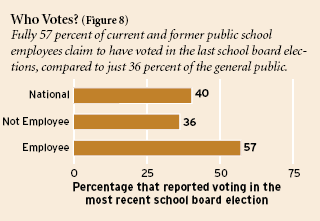
The expanding reach of federal and state policies notwithstanding, responsibility for the day-to-day management of the nation’s 14,000-plus school districts still lies primarily with locally elected school boards. Yet turnout for school board elections, which are often held at dates different from those of general elections, is notoriously low, often lingering in the single digits. Such dismal figures may make it possible for a motivated group, such as the local teachers union or advocates of a particular curricular innovation, to disproportionately influence election outcomes. One wonders, then, whether the relatively small number of voters who show up on election day share the general views of other district residents.
When using poll data to examine turnout, it is important to keep in mind that Americans consistently overstate their propensity to vote in U.S. elections. As a result, the precise proportion of Americans who claim to vote in school board elections—40 percent, in our survey—is less informative than differences in reported turnout across the various subgroups. Whites and African Americans appear slightly more likely than Hispanics to have voted in their last school board election (Q. 25). Important differences, meanwhile, are observed among public school employees and the rest of the population. Indeed, current and former public school employees are 21 percentage points more likely to claim that they voted in their last school board election than is everyone else (see Figure 8).
Support for school choice in all its forms and for NCLB appears to be somewhat weaker among voters in school board elections than among the population as a whole. Compared to the rest of the population, those who claim to have voted in the last election are 8 percentage points more likely to oppose school vouchers, 7 percentage points more likely to oppose charter schools, and 9 percentage points more likely to oppose tax credits. Voters are also 10 percentage points more likely to oppose the renewal of NCLB when the law is mentioned by name, than is the rest of the population; but when the law is described but not named, nonvoters are actually 2 percentage points more likely to oppose its renewal.
Overall Assessment
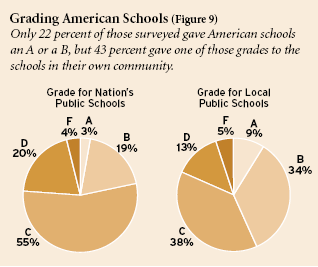
When asked to grade the public schools, respondents in this survey offer assessments that look much like those observed in other national surveys of education attitudes (see Figure 9). Forty-three percent give the schools in their own community an A or a B, 38 percent assign a C, and 18 percent give a D or F. When asked about public schools around the nation, these grades drop. Just 22 percent of Americans give public schools in general an A or B, 55 percent a C, and 24 percent a D or F.
Among the various subgroups, some interesting differences emerge. When asked about the schools around the nation, whites, Hispanics, and African Americans offer similar assessments, as do public school employees and the remaining population. When asked about the schools in their own district, however, African Americans and Hispanics give notably lower marks than whites. Fully 48 percent of whites award the schools in their community an A or B grade, as compared to 40 percent of Hispanics and 27 percent of African Americans. The responses of public school employees and everyone else do not differ significantly (Q. 26, 27).
For the most part, how Americans evaluate the public schools in their own communities does not strongly correlate with their support for the reform proposals included in this survey. One exception, though, bears mentioning. Though respondents who give their schools a C, D, or F are just as likely as respondents who give their schools an A or B to support increases in school spending, the former group is twice as likely to express no confidence that more spending will improve student learning.
Conclusions
This survey reveals a U.S. public that continues to support its public schools, but also one that wants these schools to become more effective and is willing to endorse a wide variety of reforms it thinks will bring that about. Americans, for the most part, are pragmatists. They are searching for something that works. It could be accountability, it might be choice, it could be class-size reduction, and it may be changes in teacher recruitment and pay. Reform proposals in each of these areas have pluralities in support of them. In some instances, though, sizable portions of the public remain unpersuaded by advocates on either side.
Clearly, the debate over American education is far from over.
William G. Howell is associate professor in the Harris School of Public Policy at the University of Chicago. Martin R. West is assistant professor of education at Brown University and an executive editor of Education Next. Paul E. Peterson is professor of government at Harvard University and a senior fellow at the Hoover Institution. He serves as editor-in-chief of Education Next.
|
SURVEY METHODS This survey, sponsored by Education Next and the Program on Education Policy and Governance at Harvard University, was conducted by the polling firm Knowledge Networks (KN) between February 16 and March 15, 2007. KN maintains a nationally representative panel of adults, obtained via list-assisted random digit dialing sampling techniques, who agree to participate in a limited number of online surveys. Because KN offers members of its panel free Internet access and a WebTV device that connects to a telephone and television, the sample is not limited to current computer owners or users with Internet access. When recruiting for the panel, KN sends out an advance mailing and follows up with at least 15 dial attempts. The panel, then, is updated quarterly. Detailed information about the maintenance of the KN panel, the protocols used to administer surveys, and the comparability of online and telephone surveys is available online (www.knowledgenetworks.com/quality/). The main findings from the Education Next–PEPG survey reported in this essay are based on a nationally representative stratified sample of 2,000 adults (age 18 years and older). The sample consists of 1,482 non-Hispanic whites, 233 non-Hispanic blacks, and 171 Hispanics. Within the sample, 309 individuals either currently work or previously worked for the public schools, and 1,691 individuals have had no employment in public schools. We oversampled parents of school-age children, who constitute 811 of the total sample. Because differences in the responses of parents and nonparents are negligible, we do not present the findings for these two subgroups. We use poststratification population weights to adjust for survey nonresponse as well as for the oversampling of parents. These weights ensure that the observed demographic characteristics of the final sample match the known characteristics of the national adult population. In general, survey responses based on larger numbers of observations are more precise, that is, less prone to sampling variance, than those made across groups with fewer numbers of observations. As a consequence, answers attributed to the national population are more precisely estimated than are those attributed to subgroups. With 2,000 respondents, the margin of error for responses given by the full sample in the Education Next–PEPG survey is roughly 2 percentage points. On two items, questions 1 and 18, we conducted experiments to examine the effect of variations in the way questions are posed. On question 1, the wording did appear to influence responses, so we present the results of both versions. Answers did not differ materially on question 18, so we report the average results across the two versions of that question. Additionally, to investigate the effects of question ordering, half the sample answered questions 26 and 27 at the beginning of the survey, and half did so at the end. We did not find any evidence of question order effects; hence, we present only the pooled responses in this report. Percentages do not always add precisely to 100 as a result of rounding to the nearest percentage point. |
This article appeared in the Fall 2007 issue of Education Next. Suggested citation format:
Howell, W.G., West, M.R., and Peterson, P.E. (2007). “What Americans Think About Their Schools: The 2007 Education Next-PEPG Survey.” Education Next, 7(4), 12-27.


